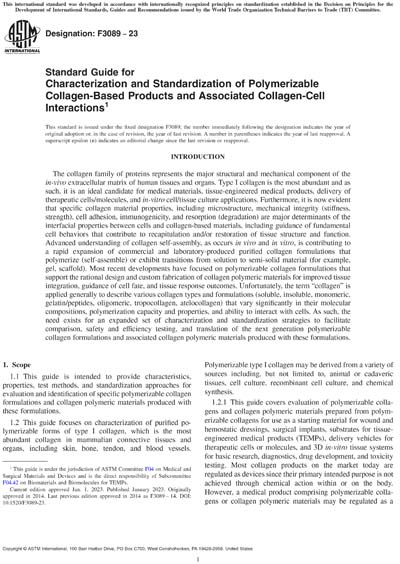Most recent
ASTM F3089-23
Standard Guide for Characterization and Standardization of Polymerizable Collagen-Based Products and Associated Collagen-Cell Interactions
1.1This guide is intended to provide characteristics, properties, test methods, and standardization approaches for evaluation and identification of specific polymerizable collagen formulations and collagen polymeric materials produced with these formulations.
1.2This guide focuses on characterization of purified polymerizable forms of type I collagen, which is the most abundant collagen in mammalian connective tissues and organs, including skin, bone, tendon, and blood vessels. Polymerizable type I collagen may be derived from a variety of sources including, but not limited to, animal or cadaveric tissues, cell culture, recombinant cell culture, and chemical synthesis.
1.2.1This guide covers evaluation of polymerizable collagens and collagen polymeric materials prepared from polymerizable collagens for use as a starting material for wound and hemostatic dressings, surgical implants, substrates for tissue-engineered medical products (TEMPs), delivery vehicles for therapeutic cells or molecules, and 3D in-vitro tissue systems for basic research, diagnostics, drug development, and toxicity testing. Most collagen products on the market today are regulated as devices since their primary intended purpose is not achieved through chemical action within or on the body. However, a medical product comprising polymerizable collagens or collagen polymeric materials may be regulated as a device, biologic, drug, or combination product depending on its intended use and primary mode of action.
1.2.2Polymerizable collagen or collagen self-assembly implies that the collagen composition exhibits spontaneous macromolecular assembly from its components without the addition of exogenous factors such as cross-linking agents. Polymerizable collagens may include but are not limited to: (1) tissue-derived monomeric collagens, including tropocollagen or atelocollagen, and oligomeric collagens; (2) collagen proteins and peptides produced through in vitro cell culture, with or without using recombinant technology; and (3) chemically synthesized collagen mimetic peptides. It should be noted that the format of collagen polymeric material products also will vary and may include injectable solutions that polymerize in situ as well as preformed sheets, particles, spheres, fibers, sponges, matrices/gels, coatings, films, and other forms.
1.2.3This guide may serve as a template for characterization and standardization of type I fibrillar collagen or other collagen types that demonstrate polymerization or self-assembly.
1.3This guide does not provide a significant basis for assessing the biological safety (biocompatibility) of polymerizable collagens and collagen polymeric materials. While the ability of collagen polymeric materials to guide cellular responses through provision of cellular adhesion and proteolytic domains as well as physical constraints (for example, structural, cell-matrix traction force) has been well documented through extensive clinical and basic research studies (1-5),2 users are directed to the ISO 10993 series for evaluating biological risks of medical devices. The biocompatibility and appropriateness of use for a specific application is the responsibility of the product manufacturer.
1.4The values stated in SI units are to be regarded as standard. No other units of measurement are included in this standard.
1.5The following precautionary caveat pertains only to the test method portion, Sections 6 and 7, of this guide: This standard does not purport to address all of the safety concerns, if any, associated with its use. It is the responsibility of the user of this standard to establish appropriate safety, health, and environmental practices and determine the applicability of regulatory limitations prior to use.
1.6This international standard was developed in accordance with internationally recognized principles on standardization established in the Decision on Principles for the Development of International Standards, Guides and Recommendations issued by the World Trade Organization Technical Barriers to Trade (TBT) Committee.
Content Provider
ASTM International [astm]






